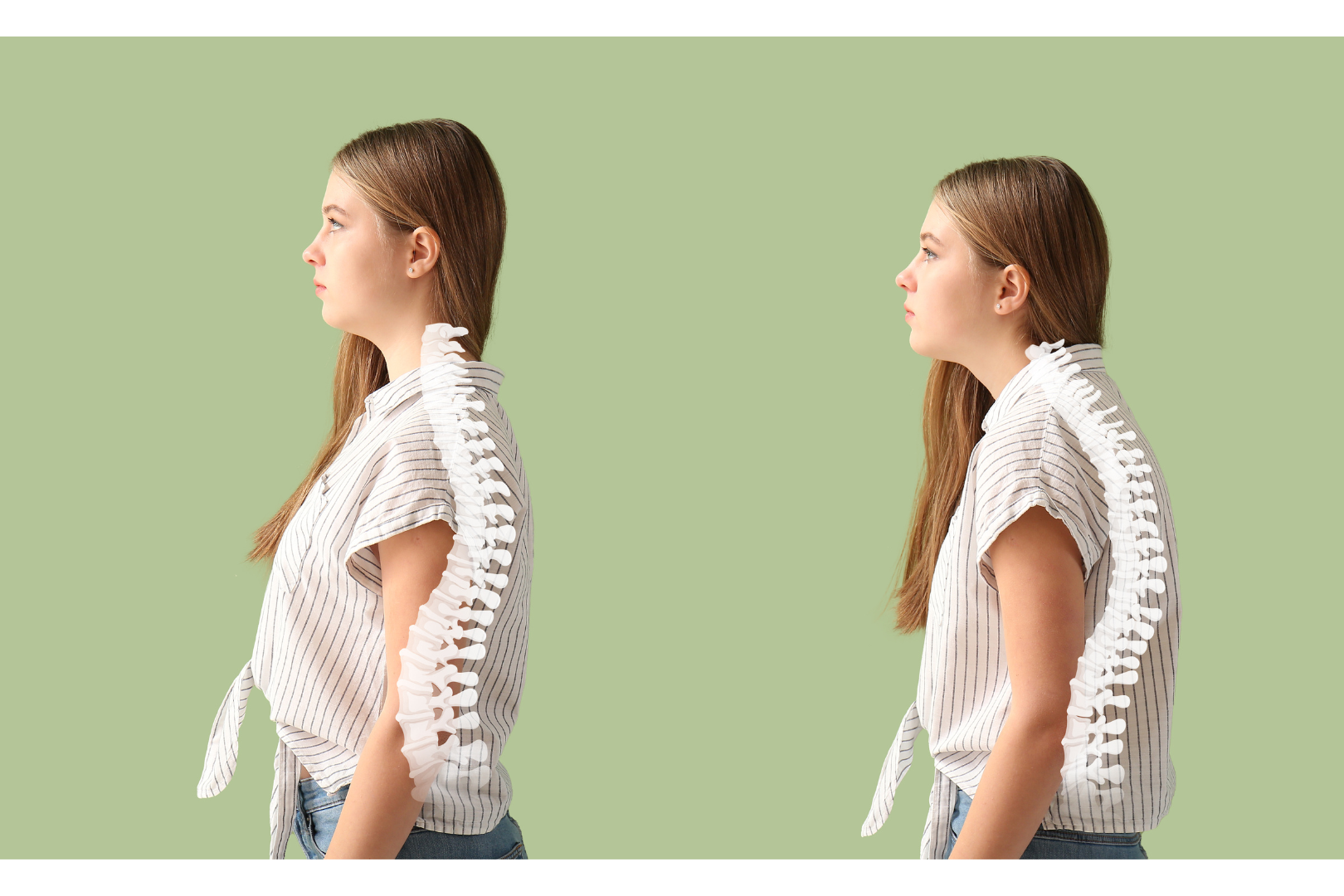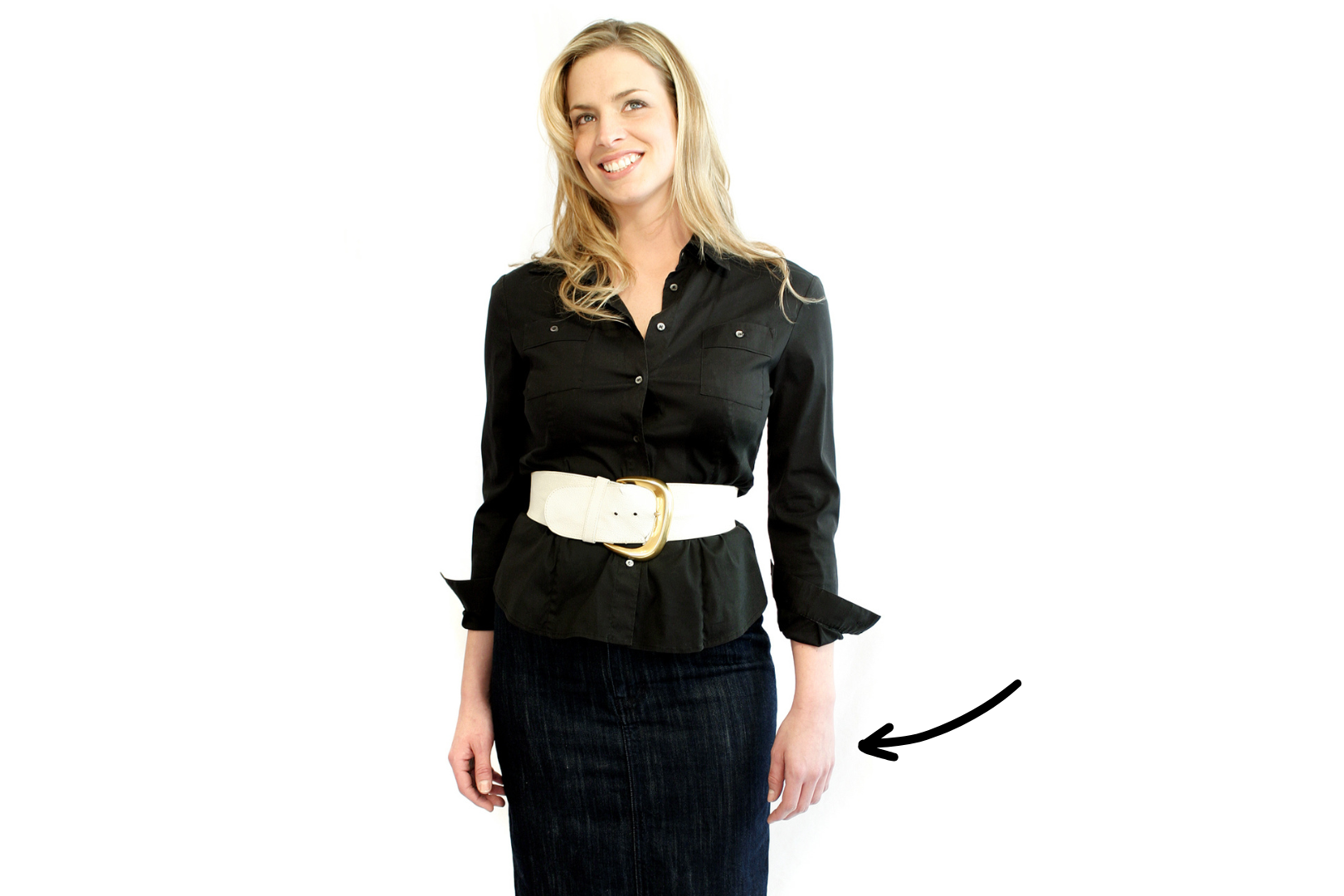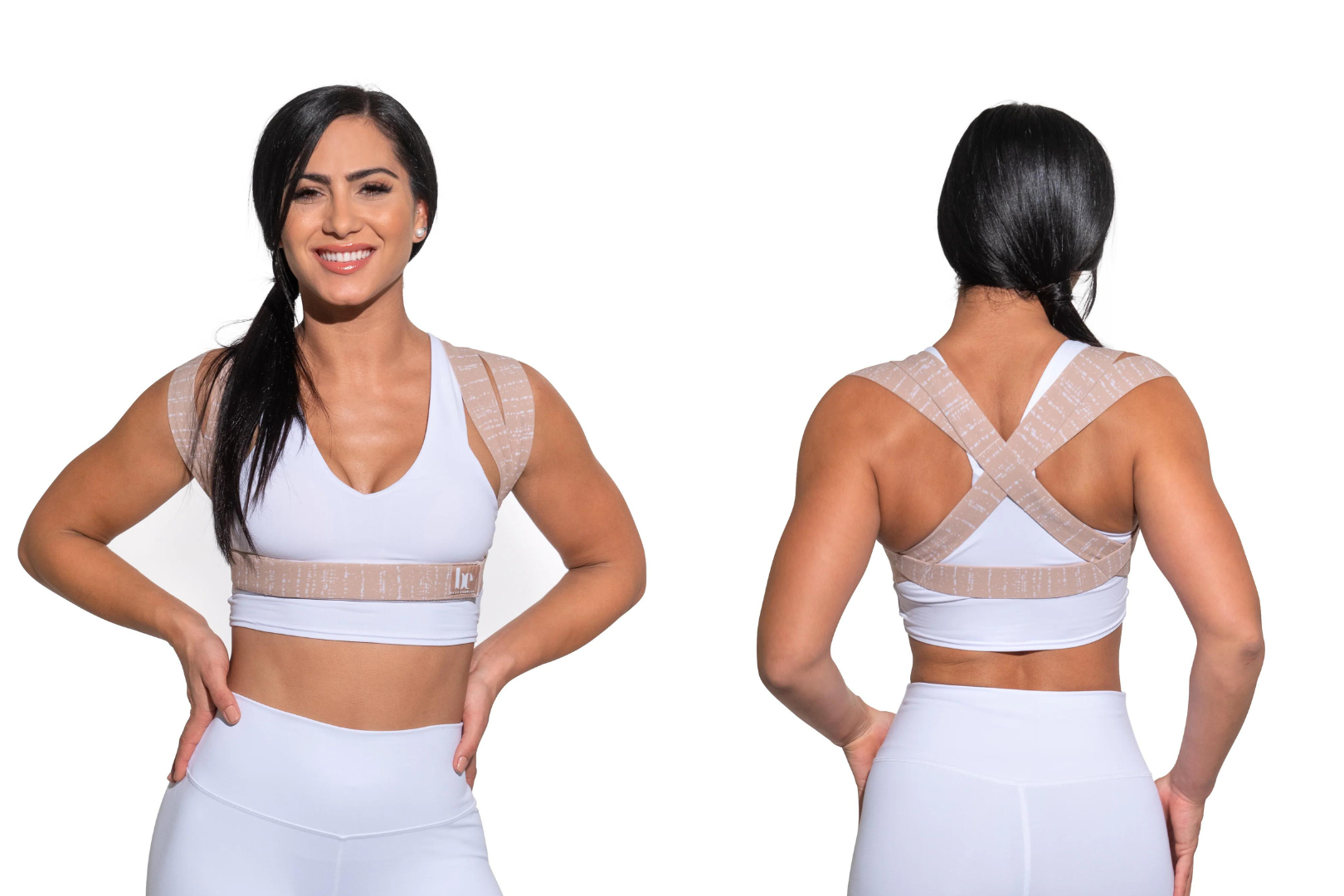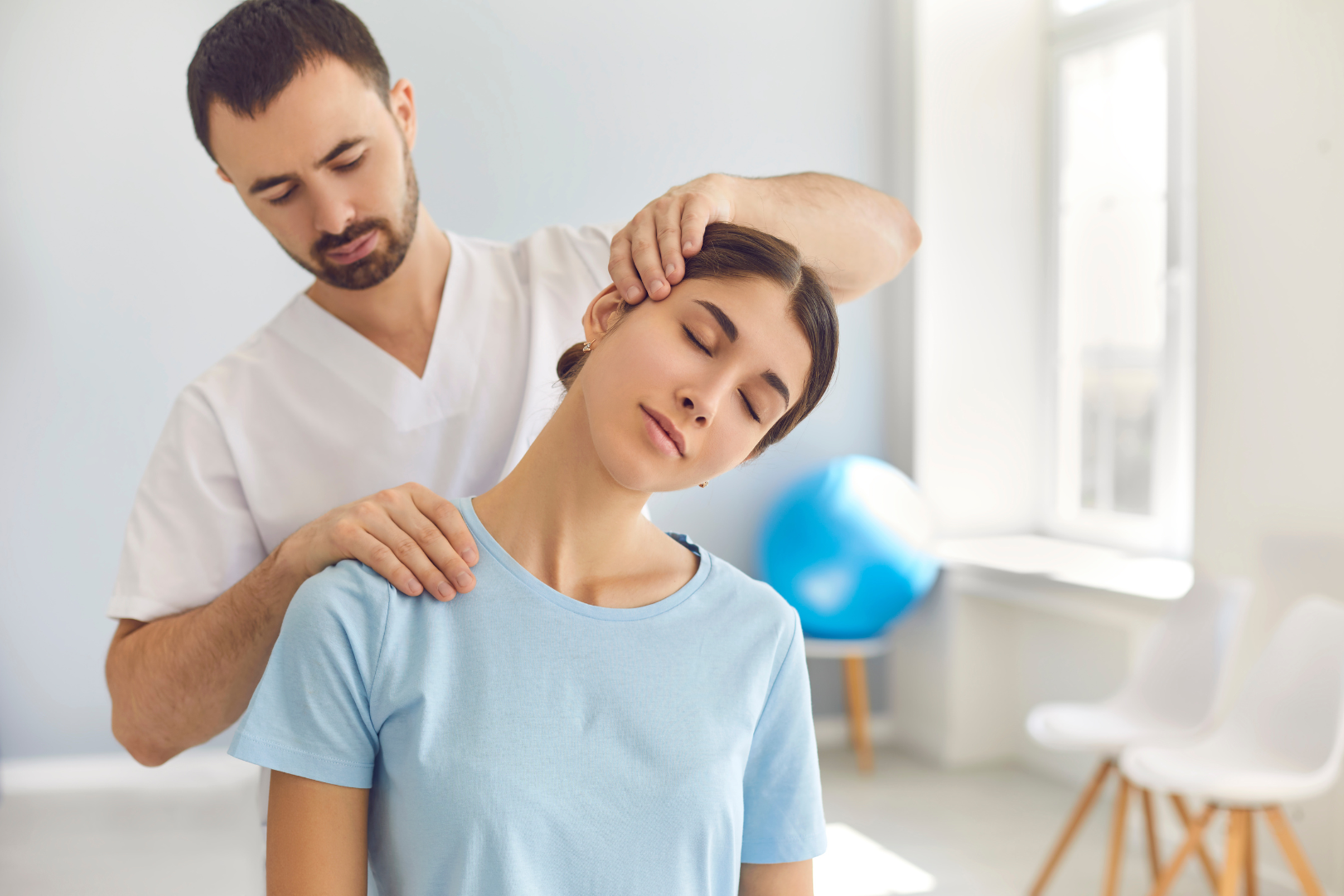Rounded shoulders are when your shoulders hunch forward, creating a stooped appearance that often accompanies forward head posture. It’s a common condition with many causes, from a sedentary lifestyle to certain athletic pursuits.
Though rounded shoulders are notorious for aesthetic issues – sometimes referred to as “mom posture” – they can also cause neck, back, and shoulder pain. Left untreated, the condition can even lead to more serious complications such as arthritis and degenerative disc disease.
The good news is you can take steps to reverse the effects of rounded shoulder by adopting good posture, which can have short-term and lasting benefits. Here’s how to fix rounded shoulders, backed by doctor recommendations.
Contents
- What are rounded shoulders?
- How to tell if you have rounded shoulders
- Rounded shoulders causes
- Rounded shoulders symptoms
- How to fix rounded shoulders
What Are Rounded Shoulders?
“The term ‘rounded shoulders’ is the idea that the shoulders are moving anterior, or forward, and it’s causing a ‘rounded’ appearance to the upper back along the line of the shoulders,” explains Dr. Brandon Mondor, DC, a chiropractor at McCabe Chiropractic & Wellness Center in Hudson, Wisconsin.
Rounded shoulders are extraordinarily common. In fact, a study of sedentary workers found that 73% had rounded right shoulders and 66% had rounded left shoulders. In other words, nearly 3 out 4 people who work desk jobs have some form of rounded shoulders.
The condition isn’t limited to those who live sedentary lifestyles, however. Another study found that more than half of collegiate athletes whose sports required overhead activities suffered from rounded shoulders.
Rounded shoulders are often accompanied by other postural conditions such as:
These conditions are likely related, so working to fix your posture for one can help resolve all of them.
Related: How to have good posture (chiropractor-approved tips)
How to Tell If You Have Rounded Shoulders
For many people, rounded shoulders are evident by simply looking in the mirror. If you’re uncertain, however, you can perform a couple of simple tests to verify if you have rounded shoulders.
Wall Test
- Stand with your behind and your heels against a wall, with your feet shoulder width apart
- Attempt to touch both shoulders to your head while keeping your eyes level
- If you can’t touch your shoulders to your head, you might have rounded shoulders
“Typically, people with rounded shoulders have a forward head as well, and this test will show that,” says Dr. Mondor.
Palm Test
- Stand straight with your arms resting naturally at your sides
- Look at your palms; they should naturally face inward toward your body
- If your palms face backwards, you might have rounded shoulders
“If your palms are facing backwards, that generally means you have tight pecs, or chest muscles, which is very typical with rounded shoulders,” says Dr. Mondor.
Rounded Shoulders Causes
From a physiological perspective, rounded shoulders (also known as protracted shoulders) are caused by muscular imbalances. Some muscles are weak and elongated, while others are tight and shortened:
Weak and elongated muscles
- Deep neck flexors (longus capitis and longus coli)
- Scapular stabilizers and retractors (rhomboids, middle and lower trapezius, teres minor and infraspinatus)
Tight and shortened muscles
- Deep upper cervical extensors (longissimus capitis, splenius capitis, cervical multifidus, upper trapezius)
- Shoulder protractors and elevators (pectoralis minor, pectoralis major, and levator scapula)
Source: National Library of Medicine
“The cause of rounded shoulders is due to a muscle imbalance between the front of the chest and the upper and mid-back, usually due to poor posture,” says Dr. Mondor. “Having poor forward posture causes the muscles in the chest region to become overactive and tight, and the muscles in the upper and mid-back region to be overstretched and become weak.”
These muscle imbalances are often caused by work and lifestyle activities, including:
- Slouching at desk jobs
- Working overhead
- Repeatedly lifting and carrying heavy objects, including backpacks
- Craning one’s neck to read or view mobile devices, which can also cause tech neck
“Activities that can cause rounded shoulders are those that require the arms to be out in front of the body for long periods of time, such as prolonged desk work, driving a vehicle, and working at a computer, along with others, but these are the common causes among people today,” says Dr. Mondor.
How to fix tech neck, according to doctors
Rounded Shoulders Symptoms
Symptoms of rounded shoulders include:
- A stooped appearance
- Pain in the back of the neck
- Burning pain between the shoulder blades
- Headaches
- Tender points between the shoulder and neck on each side
- Low back pain
- Jaw pain
- Muscle weakness
- Reduced range of motion
- Respiratory issues
How to prevent back pain when sitting
“Things you may notice but not have pain with are a decreased ability to turn your neck left and right, not being able to move your arms as far in all directions, possible weakness in the arms, and a decreased ability to breath as deeply due to the inability to open up the chest and expand the lungs,” explains Dr. Mondor.
Left untreated, rounded shoulders can lead to more complicated health issues, including:
- Circulatory problems
- Arthritis
- Disc herniation
- Degenerative disc disease
- Compressed nerves and loss of nerve function
“Not treating rounded shoulders can be very detrimental to someone’s health by way of how it affects the spine,” says Dr. Mondor. “When shoulders ‘round,’ it will cause an increase in the curve of the middle of the back, also known as the thoracic spine. Over time, that increase in curve is going to cause a change in the structure of the spine and how weight is distributed, which can cause early degeneration to the front of the spine and compress nerves, not allowing them to function as they should. That loss of nerve function means loss of function to tissues they send signals to, such as muscles and organs.”
Rounded shoulders can even affect your confidence, as studies have found that body posture influences how confident you look and feel.
How to fix hunchback, according to doctors and therapists
How to Fix Rounded Shoulders
With a proper treatment plan, you can reverse the effects of rounded shoulders and reclaim proper posture.
Use a Posture Corrector
Studies have proven that posture correctors are effective at reducing rounded shoulders. Also known as posture braces, these devices work in two ways:
- Active: Posture correctors gently retract your shoulders, guiding you into proper posture and offsetting muscular imbalances
- Passive: They also offer continual physiological feedback, gradually training you to maintain good posture on your own
Do posture correctors work? Here’s what back doctors say
“Posture correctors are great for fixing rounded shoulders. They allow for the same muscle memory that you can achieve doing stretches and exercises, but with the ability to move around and do things that still need to get done,” says Dr. Mondor. “Posture correctors are going to force the shoulders backward, or posterior, as well as bring the shoulder blades closer together, taking some strain off the muscles in the back.”
Dr. Mondor adds that posture correctors should be used in conjunction with exercises and stretches to improve strength so that, eventually, you can maintain proper posture without the device.
Posture corrector before & after photos & stories
The best back braces for rounded shoulders are those recommended by doctors, since they’re proven to work, and constructed from high-quality materials that last. They should also be comfortable, since the most effective posture corrector is one you will wear daily. Some models are lightweight enough to be worn under clothes yet stylish enough to be worn over clothes – for both men and women.
Exercises, Stretches, and Yoga
Exercises, stretches, and yoga can help strengthen weak, elongated muscles and stretch tight, shortened muscles, reversing imbalances to help eliminate rounded shoulders.
20 best posture stretches (recommended by posture pros)
Dr. Mondor recommends the following exercises and stretches for rounded shoulders:
Wall Angels
- Stand with the backs of your heals and your behind against a wall
- Touch your shoulders and the back of your head to the wall
- Turn your arms so the backs of your hands are touching the wall
- Hold that position for one minute, step away, then repeat
Doorway Stretch
- Stand in a doorway and place each forearm and palm flat against each side of the frame
- Using your whole body, take a small step forward with one leg and lean into it
- You should feel a stretch on both sides of the front of your chest
- Hold for 30 to 60 seconds, rest, and repeat
- Work toward leaning farther forward each time, creating a bigger stretch
Other exercises and stretches that can help reduce rounded shoulders include:
Band Pull Aparts
Planks
Wall Slides
Neck Flexion Stretch
Chin Tucks
Set Up an Ergonomic Workstation
Whether you work a desk job, on an assembly line, or on the road, an ergonomic setup can help you maintain good posture and avoid rounded shoulders.
How to fix forward head posture: Tips from doctors and PTs
Tips include:
- Setting your monitor at the right height, so the top of the screen is at eye level
- Practicing proper sitting posture
- Using an ergonomic desk chair
- Using a standing desk so you can switch between sitting and standing
Learn more about proper sitting posture and the best typing posture to prevent rounded shoulders at work.
Practice Mindfulness
It’s easy to get stuck in routines and lose sight of our posture, but practicing mindfulness can go a long way toward preventing rounded shoulders and other postural issues.
Consider downloading a posture app or slouch detector. Some posture apps provide regular reminders to get up, move around, and change positions so you’re not stuck in the same posture all day. Slouch detectors use your webcam to actively monitor your posture and sound an alarm when you slouch.
Dynamic posture is the practice of regularly switching positions so you’re not sitting or standing with static posture all day. Remain cognizant of your posture so you can work on correcting it yourself.
How to stop slouching (doctor-recommended advice)
Chiropractic Care
A chiropractor can develop a treatment plan that incorporates a combination of adjustments, physical therapy, posture correctors, and exercises and stretches. A comprehensive strategy like this is the best way to correct rounded shoulders and prevent them from recurring.
Bad posture causes headaches: Here’s how to stop them
Dr. Mondor stresses that it’s important to see a chiropractor whether you’re experiencing pain or not, and it’s best to get treatment as soon as you notice your shoulders rounding because fixing it early will prevent future problems and pain.
“A chiropractor is going to assess the spine and determine what subluxations are present that may be affecting the nerves sending signals to the muscles controlling the shoulders, and allow them to function as they should, which results in the muscles being able to functions as they should,” explains Dr. Mondor. “Chiropractic care, along with some exercise and stretching, is a great way to prevent problems like rounded shoulders from ever happening.”
Dr. Mondor says an example regimen for correcting rounded shoulders might look like this:
- Performing exercises and stretches daily
- Wearing a posture corrector for periods of time throughout each day
- Frequent chiropractic care
Depending on the patient, Dr. Mondor says chiropractic care might begin with three weekly session for two to four weeks, then taper to twice weekly, once weekly, every other week, then once monthly for maintenance to keep you aligned and able to do what you want for the rest of your life.
Rounded shoulders can cause aesthetic issues, pain, and even long-term health problems. Follow the doctor recommendations listed here to fix rounded shoulders and enjoy pain-free mobility by training your body to maintain good posture.












